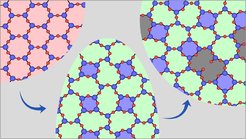Thin film oxides: From honeycombs to quasicrystals
Breaking translational symmetry while maintaining long range order is one fascinating aspect of quasicrystals. For two-dimensional oxide quasicrystals, researchers at the Martin-Luther-University Halle-Wittenberg, the National Institute of Standards and Technology, the Max Planck Institute Halle, and the University Grenoble-Alpes settle a long-standing question and explain the mechanism by which quasicrystrals are formed using a combination of x-ray diffraction experiments and first-principles energy stability calculations. This work was published in Nature Communications on December 7th, 2022.
Oxide quasicrystals show a 12-fold rotational symmetry with a complex structure formed from the self-similar tiling of triangles, squares and rhombuses that exhibits a well-developed long-range order. Since their discovery in Halle in 2013, the detailed formation of the structure has been under debate. In a Nature Communications article, the international team of physicists solve the riddle by a combined experimental and theoretical approach. They explain the quasicrystal structure as a network of titanium and oxygen rings TinOn with ring sizes of n=4, 7, and 10, with the larger rings hosting Ba or Sr atoms.
Other two-dimensional materials such as graphene and numerous metal oxides form periodic honeycomb structures with a ring size n=6; two-dimensional Ti2O3 itself forms such a periodic honeycomb. Here the team reports that metal-oxide structures with different ring sizes can form through well-defined transformations of the honeycomb structure. Lead scientist Stefan Förster points out: “Surprisingly, ring transformation mechanisms known from other 2D honeycomb structures are the key element for understanding the quasicrystal formation with its dodecagonal long-range order.” Furthermore, using electronic-structure-based total energy calculations, the authors show how the formation of the larger rings is stabilized by the addition of Ba or Sr.
Understanding the formation of these complex structures in this particular two-dimensional oxide reveals a path towards synthesizing a variety of complex periodic structures and quasicrystals in other thin film systems and the engineering of their properties.
This project was funded in part by the Deutsche Forschungsgemeinschaft (DFG, German Research Foundation) - 406658237 and SFB 762.













